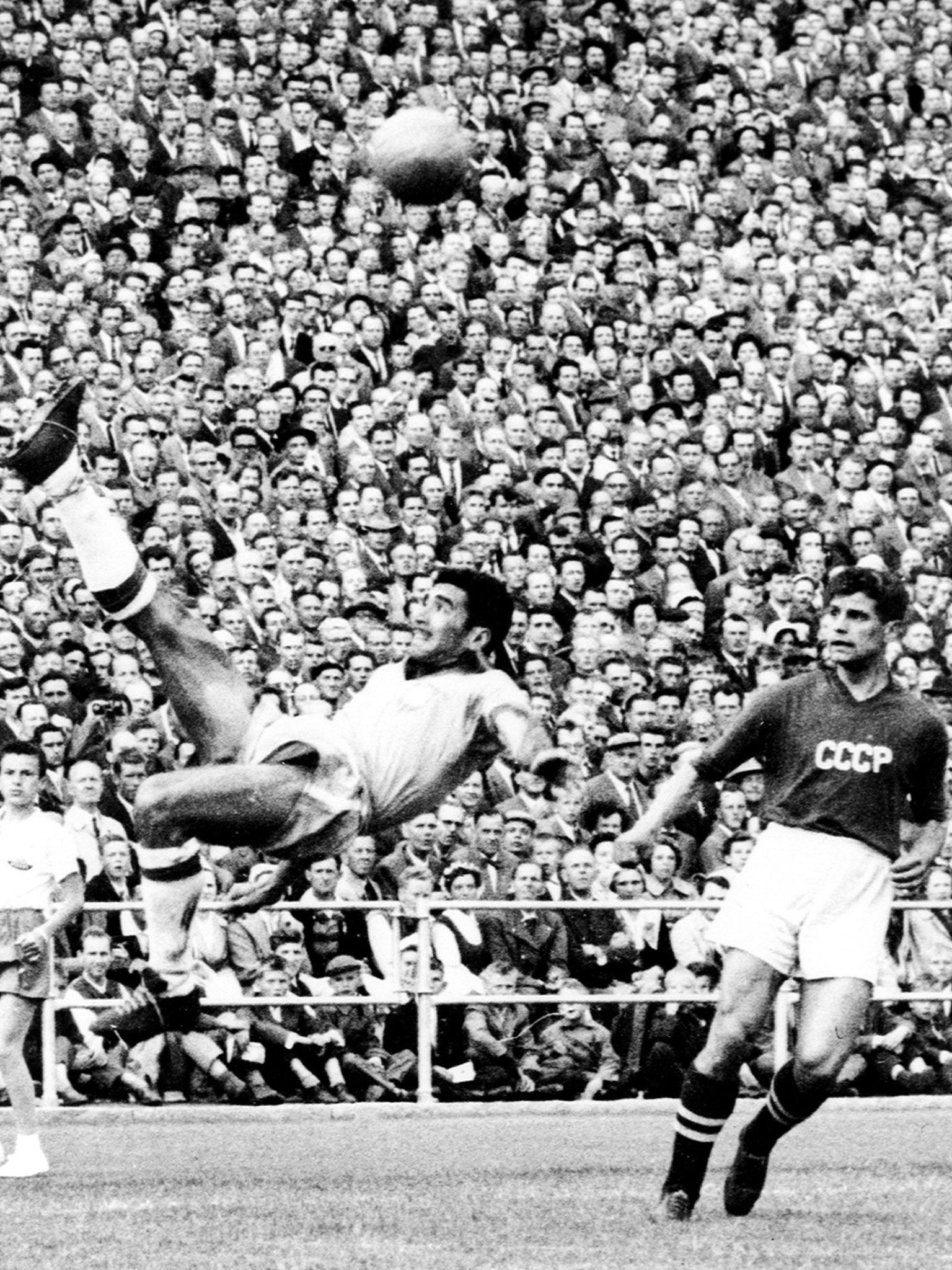Nilton Santos: Footballer
Double World Cup-winner who began his career up front but went on to pioneer the role of attacking full-back

With a debonair bearing that oozed style and confidence, and handsome looks topped off by a fashionable pencil moustache, Nilton Santos might have been an idol of the silver screen. In fact he was left-back in one of the most revered football teams of all time, the Brazil side which lifted the World Cup in 1958 and retained it four years later, an elegant performer both solid and scintillating. Poignantly, two of his closest comrades in the Selecao rearguard, right-back Djalma Santos (no relation) and goalkeeper Gilmar, died earlier this year.
Nilton Santos, nominated by his incomparable compatriot Pele as one of the 125 greatest living footballers in 2004 and named in the world team of the 20th century by journalists in 1998, complemented his muscular, more down-to-earth full-back partner perfectly. Endowed with magnificent all-round technique, he was a composed and complete performer who could have excelled in any area of the pitch. Tall and powerful but never a thunderous tackler in the manner of his namesake, he was expert in nicking the ball away from opponents with crisp, beautifully timed challenges and intelligent interceptions, born of his acute positional sense. As a result, he tended to remain injury-free, unusual for a defender of his vintage.
Santos was also a pioneer of the exhilarating overlap in an era when most full-backs ventured forward only rarely. Never were his attacking instincts illustrated more vividly than at Uddevalla in Sweden in the Brazilians’ opening game of the 1958 World Cup, which ended in a 3-0 win over Austria. After winning the ball deep in his own territory, he carried it to the halfway line, where he passed to Jose Altafini. Then, instead of retreating to his defensive slot as was expected of full-backs at the time, he continued surging forward, accepted a return pass and scored with a powerful shot.
As Santos dribbled, his coach Vicente Feola had been close to apoplexy, fearful of the gap being left at the back, and he was heard to shout: “Crazy, crazy... Oh, well done!” That spectacular manoeuvre fired the imagination of full-backs the world over, and the game became all the more entertaining as a result.
Santos made his initial impact with the Rio de Janeiro club Botafogo, joining from junior football as a 23-year-old attacker in 1948. At first he wasn’t thrilled by the suggestion that he should switch to the back line, but he did so and put his inimitable stamp on his fresh role. He became a loyal one-club man, helping to garner serial silverware, including the state championships of 1948, 1957, 1961 and 1962.
But it was in the international arena that he made his most indelible mark after collecting the first of his 75 caps in a 5-0 drubbing of Colombia in spring 1949. Soon he became a regular in the yellow No 3 shirt, delighting the fans with his cultured methods, though it was for untypical pugilism that he hit the headlines during the 1954 World Cup finals in Switzerland. Brazil’s quarter-final clash with the marvellous Hungarians was expected to be a classic, but instead it descended into an undignified scrap, entering folklore as the Battle of Berne. Santos and the Magyars’ captain Josef Bozsik, who also happened to be a member of his national parliament, were sent off for fighting as the South Americans lost 4-2.
The left-back had another day to forget when he captained Brazil in their 4-2 defeat by England at Wembley in May 1956, getting the runaround from the wing wonder Stanley Matthews, but it was a different story two years later in Sweden, when he didn’t miss a game on his majestic Pele-inspired team’s way to the world crown. His display against the Swedish star winger Kurt Hamrin in the final was hailed as a masterpiece as Brazil won 5-2, the occasion garnished further for Santos by the brilliance of his protégé, the right-winger Garrincha.
Several years earlier Santos had been nutmegged on the training pitch by an awkward rookie, whom he urged Botafogo to snap up. They did so, the maverick Garrincha hit the heights and the two became close, with the younger man invariably moderating his notoriously wild behaviour when around Santos out of respect for his mentor. That was just one of many insightful interventions in the affairs of club and country by Santos, who was known as “The Encyclopedia” for his comprehensive knowledge of the game.
Come the 1962 finals in Chile, by then deployed in a more central defensive position, he was ever-present again as Brazil retained the Jules Rimet Trophy, beating Czechoslovakia 3-1 in the Santiago final. That was the international swansong of the 37-year-old, who played on for Botafogo until 1964 then took up coaching. His contribution to the game was aptly summed up by Zito, one of his most eminent team-mates, who said: “When you played the ball as much as he did, the position didn’t really matter ... Nilton Santos wasn’t a defender or a full-back. He was just a star, it was as simple as that.”
Nilton Reis dos Santos, footballer: born Ilha do Governador, near Rio de Janeiro 16 May 1925; played for Botafogo 1948-64; capped 75 times by Brazil 1949-62; died Rio de Janeiro 27 November 2013.
Subscribe to Independent Premium to bookmark this article
Want to bookmark your favourite articles and stories to read or reference later? Start your Independent Premium subscription today.

Join our commenting forum
Join thought-provoking conversations, follow other Independent readers and see their replies